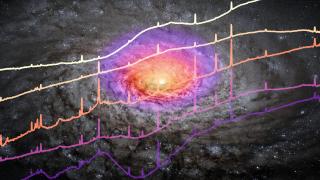Bibcode
Badole, Shruti; Jackson, Neal; Hartley, Philippa; Sluse, Dominique; Stacey, Hannah; Vives-Arias, Héctor
Bibliographical reference
Monthly Notices of the Royal Astronomical Society
Advertised on:
5
2020
Citations
15
Refereed citations
11
Description
We present Karl G. Jansky Very Large Array (VLA) and Atacama Large Millimetre Array (ALMA) observations of SDSS J0924+0219, a z = 1.524 radio-quiet lensed quasar with an intrinsic radio flux density of about 3 $\, \mu$ Jy. The four lensed images are clearly detected in the radio continuum and the CO(5-4) line, whose centroid is at z = 1.5254 ± 0.0001, with a marginal detection in the submillimetre continuum. The molecular gas displays ordered motion, in a structure approximately 1-2.5 kpc in physical extent, with typical velocities of 50-100 km s-1. Our results are consistent with the radio emission being emitted from the same region, but not with a point source of radio emission. SDSS J0924+0219 shows an extreme anomaly in the flux ratios of the two merging images in the optical continuum and broad emission lines, suggesting the influence of microlensing by stars in the lensing galaxy. We find the flux ratio in the radio, submillimetre continuum and CO lines to be slightly greater than 1 but much less than that in the optical, which can be reproduced with a smooth galaxy mass model and an extended source. Our results, supported by a microlensing simulation, suggest that the most likely explanation for the optical flux anomaly is indeed microlensing.
Related projects

Nuclear Activity in Galaxies: a 3D Perspective from the Nucleus to the Outskirts
This project consists of two main research lines. First, the study of quasar-driven outflows in luminous and nearby obscured active galactic nuclei (AGN) and the impact that they have on their massive host galaxies (AGN feedback). To do so, we have been granted time with the Gran Telescopio CANARIAS (GTC) in the optical and near-infrared ranges
Cristina
Ramos Almeida